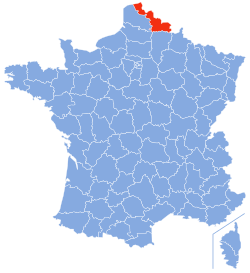
Back Nord Afrikaans Département Nord ALS Norte (Francia) AN نور (إقليم فرنسي) Arabic Nord AST Nor (departament) Azerbaijani Nord (departemén Prancis) BAN Нор (дэпартамент) Byelorussian Нор BE-X-OLD Нор Bulgarian
Nord | |
|---|---|
 Prefecture building of the Nord department, in Lille | |
 Location of Nord in France | |
| Coordinates: 50°23′N 03°19′E / 50.383°N 3.317°E | |
| Country | France |
| Region | Hauts-de-France |
| Prefecture | Lille |
| Subprefectures | Avesnes- sur-Helpe Cambrai Douai Dunkirk Valenciennes |
| Government | |
| • President of the Departmental Council | Christian Poiret[1] |
| Area | |
• Total | 5,743 km2 (2,217 sq mi) |
| Population (2022)[2] | |
• Total | 2,616,909 |
| • Rank | 1st |
| • Density | 460/km2 (1,200/sq mi) |
| Time zone | UTC+1 (CET) |
| • Summer (DST) | UTC+2 (CEST) |
| ISO 3166 code | FR-59 |
| Department number | 59 |
| Arrondissements | 6 |
| Cantons | 41 |
| Communes | 648 |
| ^1 French Land Register data, which exclude estuaries, and lakes, ponds, and glaciers larger than 1 km2 | |
Nord (French pronunciation: [nɔʁ] ⓘ; officially French: département du Nord; Picard: départémint dech Nord; Dutch: Noorderdepartement, lit. 'Northern Department') is a département in Hauts-de-France region, France bordering Belgium. It was created from the western halves of the historical counties of Flanders and Hainaut, and the Bishopric of Cambrai. The modern coat of arms was inherited from the County of Flanders.
Nord is the country's most populous département. It had a population of 2,608,346 in 2019.[3] It also contains the metropolitan region of Lille (the main city and the prefecture of the département), the fourth-largest urban area in France after Paris, Lyon and Marseille. The department is the part of France where the French Flemish dialect of Dutch has historically been spoken as a native language. Similarly, the distinct French Picard dialect Ch'ti is spoken there.
- ^ "Répertoire national des élus: les conseillers départementaux". data.gouv.fr, Plateforme ouverte des données publiques françaises (in French). 4 May 2022.
- ^ "Populations de référence 2022" (in French). The National Institute of Statistics and Economic Studies. 19 December 2024.
- ^ Populations légales 2019: 59 Nord, INSEE

